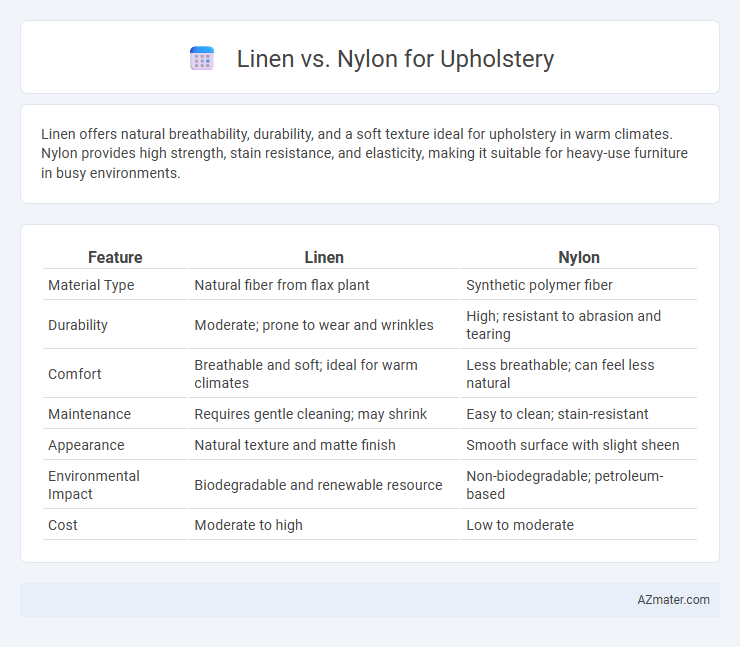Linen offers natural breathability, durability, and a soft texture ideal for upholstery in warm climates. Nylon provides high strength, stain resistance, and elasticity, making it suitable for heavy-use furniture in busy environments.
Table of Comparison
| Feature | Linen | Nylon |
|---|---|---|
| Material Type | Natural fiber from flax plant | Synthetic polymer fiber |
| Durability | Moderate; prone to wear and wrinkles | High; resistant to abrasion and tearing |
| Comfort | Breathable and soft; ideal for warm climates | Less breathable; can feel less natural |
| Maintenance | Requires gentle cleaning; may shrink | Easy to clean; stain-resistant |
| Appearance | Natural texture and matte finish | Smooth surface with slight sheen |
| Environmental Impact | Biodegradable and renewable resource | Non-biodegradable; petroleum-based |
| Cost | Moderate to high | Low to moderate |
Introduction to Linen and Nylon in Upholstery
Linen and nylon are popular upholstery fabrics, each offering distinct characteristics that influence furniture durability and aesthetics. Linen, derived from flax fibers, provides a natural, breathable texture with a timeless appearance, making it ideal for eco-conscious and stylish interiors. Nylon, a synthetic polymer, is renowned for its exceptional strength, abrasion resistance, and easy maintenance, making it suitable for high-traffic areas requiring long-lasting upholstery.
Material Composition and Characteristics
Linen upholstery is made from natural flax fibers, offering breathability, moisture-wicking properties, and a durable yet soft texture that becomes more comfortable with use. Nylon, a synthetic polymer, provides exceptional strength, elasticity, and resistance to abrasion and stains, making it highly durable and easy to maintain for high-traffic furniture. Linen tends to wrinkle and may require more care, while nylon's smooth finish resists pilling and fading, offering a more resilient option for upholstery applications.
Durability Comparison: Linen vs Nylon
Nylon upholstery offers superior durability compared to linen, with high resistance to abrasion, stretching, and pilling, making it ideal for heavy-use furniture. Linen fibers, while strong, are more prone to wear and tear, fading, and stains, requiring careful maintenance to preserve longevity. For long-lasting upholstery, nylon's robust synthetic composition outperforms the natural texture of linen in durability and resilience.
Comfort and Texture Differences
Linen upholstery offers a natural, breathable texture that provides a cool and comfortable seating experience, ideal for warm climates. Nylon upholstery is smoother and more durable but tends to feel less breathable and can retain more heat, making it less comfortable in hot conditions. The natural fibers of linen create a soft, textured surface, while nylon's synthetic composition results in a slicker, more uniform texture.
Aesthetic Appeal and Style Options
Linen upholstery offers a natural, elegant texture with a matte finish that enhances light, airy interiors and supports a classic or rustic aesthetic. Nylon fabrics provide a smooth, glossy surface available in vibrant colors and diverse patterns, making them ideal for modern, high-traffic settings requiring durability and stain resistance. Choosing between linen and nylon depends on the desired balance between organic charm and contemporary versatility in upholstery design.
Maintenance and Cleaning Requirements
Linen upholstery demands gentle cleaning methods, typically requiring professional dry cleaning or spot cleaning with mild detergents to maintain its natural fibers and prevent shrinkage. Nylon upholstery offers greater durability and ease of maintenance, with its stain resistance allowing for regular vacuuming and spot cleaning using water-based cleaners without compromising fabric integrity. Choosing nylon reduces long-term cleaning effort and costs, while linen requires more careful upkeep to preserve its texture and appearance.
Stain and Fade Resistance
Nylon upholstery excels in stain and fade resistance due to its synthetic fibers that repel liquids and resist UV damage, making it ideal for high-traffic areas and sunlight exposure. Linen, while natural and breathable, tends to absorb stains more readily and can fade faster when exposed to direct sunlight over time. Choosing nylon enhances durability and longevity in upholstery where stain and fade resistance are critical concerns.
Environmental Impact and Sustainability
Linen, derived from flax plants, is highly sustainable due to its biodegradability, low water usage, and minimal pesticide requirement during cultivation. Nylon, a synthetic polymer made from petrochemicals, poses environmental challenges such as high energy consumption, non-biodegradability, and microplastic pollution. Choosing linen for upholstery reduces ecological footprints and supports eco-friendly material sourcing compared to nylon's reliance on fossil fuels and its longer decomposition period.
Cost and Affordability
Linen upholstery tends to be more expensive due to its natural fibers and labor-intensive production, making it a premium choice for durability and breathability. Nylon upholstery is generally more affordable, offering strong stain resistance and durability at a lower price point. Consumers seeking budget-friendly options often prefer nylon for its cost-effectiveness without sacrificing performance.
Choosing the Right Fabric for Your Upholstery Needs
Linen offers a natural, breathable texture ideal for upholstery in warm climates, providing durability and a soft, elegant appearance that ages gracefully with use. Nylon, known for its exceptional strength and resistance to abrasion and stains, suits high-traffic areas requiring long-lasting, easy-to-clean fabrics. Selecting the right upholstery fabric depends on balancing factors like desired comfort, durability, maintenance, and the specific environment where the furniture will be used.

Infographic: Linen vs Nylon for Upholstery
 azmater.com
azmater.com